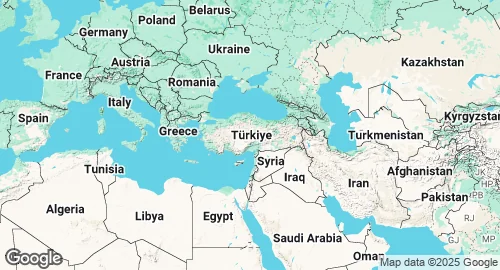Turkey Military Forces 🇹🇷
Military Strength Overview
| 🛩️ Air Force | 1,098 active aircraft |
| ⚓️ Naval forces |
215 ships in fleet
– incl. 18 submarines |
| ☢️ Nuclear Deployment | Hosting 50 warheads |
| 🪖 Active Troops | 355,200 personnels |
| ⛑️ Reserve Troops | 378,700 personnels |
| 👮♀️ Paramilitary | 156,800 personnels |
| 🎖️ Military ranks | 77 ranks listed |
Defense Statistics & Key Metrics
| Population | 85.3 million (2023) |
| GDP | $1.1 trillion (2023) |
| GDP per capita | $13106 (2023) |
| Military Budget | $25.0 billion (2024) |
| Share of GDP in Milex | 1.9% (2024) |
| Military spends per capita | $293 |
| Inflation Rate | 58.51% (2024) |
| Military Personnel | 512,000 (2020) |
Strategic Overview in 2025
The Republic of Turkey stands as a formidable and complex actor at the strategic crossroads of Europe, Asia, and the Middle East. As NATO's second-largest military, it wields significant influence, though its pursuit of "strategic autonomy" often creates friction with Western allies. Ankara's foreign policy is increasingly interventionist, leveraging its military to secure national interests from the Eastern Mediterranean to the Caucasus and North Africa.
Military Forces and Defense Industry
The Turkish Armed Forces (TAF) are among the largest in NATO, with approximately 355,000 active personnel and a substantial reserve force. The Land Forces are extensive, operating thousands of tanks and armored vehicles, including modernized Leopard tanks and the domestically produced Altay main battle tank. The Air Force commands a large fleet of F-16 fighter jets, alongside a world-renowned arsenal of unmanned aerial vehicles (UAVs) like the Bayraktar TB2. The Navy is undergoing significant modernization, centered on the "Blue Homeland" (Mavi Vatan) doctrine, developing new frigates, corvettes, and the TCG Anadolu amphibious assault ship.
A key element of Turkey's strength is its rapidly growing defense industry. Aiming to meet over 80% of its needs domestically by 2025, the sector produces a wide array of advanced systems, from missiles and electronic warfare systems to naval platforms. This indigenous capability reduces reliance on foreign suppliers—a crucial lesson from past arms embargoes—and has turned Turkey into a major arms exporter, enhancing its geopolitical leverage.
Current and Foreseeable Strategic Trends
Turkey's military posture is shaped by concurrent challenges and ambitions. In the Eastern Mediterranean, Ankara is asserting its maritime claims through the "Blue Homeland" doctrine, leading to disputes with Greece and Cyprus over Exclusive Economic Zones (EEZs) and energy resources. This has led to a more assertive naval presence and military-backed diplomacy, such as its security agreement with Libya, to prevent strategic encirclement.
In the Black Sea, Turkey performs a delicate balancing act. It manages its complex relationship with Russia while upholding its NATO commitments. Ankara has invoked the Montreux Convention to limit naval passage during the Ukraine war, supplied drones to Kyiv, and co-led a demining task force with Romania and Bulgaria. At the same time, it avoids direct confrontation with Moscow and pursues diplomatic channels, as seen in its mediation of the grain deal.
Looking ahead, Turkey will continue to use its military might and defense-industrial base to project power and secure its interests. Its focus on strategic autonomy means it will likely maintain a transactional approach to alliances, balancing cooperation with unilateral action to address perceived threats and opportunities in its volatile neighborhood.
Turkish Military Budget History
Population and Military Personnel Trends
GDP and Inflation Rate Trends
Turkish Aircraft Manufacturing
| Model | Manufacturer | Year | Number |
|---|---|---|---|
| Calidus B250 | Novaer | 2017 | 2 |
| Bayraktar TB2 | Baykar | 2014 | 600 |
| Hürkus | TAI | 2013 | 18 |
Military Expenditure: SIPRI Milex.
